The Windows RT Review
by Vivek Gowri & Anand Lal Shimpi on October 25, 2012 12:00 PM EST- Posted in
- Windows RT
- Operating Systems
- Microsoft
- Mobile
- Windows 8
- Tablets
First Party Applications
Microsoft has bundled in a healthy suite of first party applications for Modern UI, including obvious suspects like Internet Explorer, Mail, Calendar, People, Maps, Messaging, and Bing, as well as apps for things like news, finance, sports, weather, remote desktop, and media playback, amongst others.
There’s also a list of desktop applications that’s a little less heartening. The familiar old Windows Accessories are still sticking around, with favorites like Paint and Notepad joined here by the classic Remote Desktop Connection application, Snipping Tool (another holdover from the Windows Tablet PC days), the Math Input Panel, and XPS document viewer. Ease of access applications, too, are desktop-based, as are system functions like Control Panel, Command Prompt, File Explorer, Task Manager, and the Run dialog. Personally, I’m disappointed that there wasn’t a Modern UI version of Command Prompt because, let’s face it, how cool would that be?
You’ll note that I left out the headlining Windows RT application: Office 2013. It’s one of the most vital pieces to the Windows RT puzzle, so it demands a bit more context - I’ll get to it in a bit, after running through some of the more notable first party applications.
The mail application here is decent, with an ultra-spartan design and a straightforward 3-column layout. You get accounts and folders on the far right, a middle column with the sender, subject, and thread information. When you expand a multi-email thread, a message preview is also shown. Finally, in the main part of the window, the selected message is displayed. If you’ve used any recent version of Outlook or Hotmail, the layout and implementation should be instantly familiar except for the Metro visual style. Compose, reply, and delete are located in the top right corner of the email window, while mark as unread and move to folder are located in the bottom edge swipe bar.
As far as options go, there really isn't much to mess with - just the ability to turn off threaded messaging. You can connect any EAS, IMAP, or POP email accounts, with support for Hotmail, Gmail, Exchange, AOL, and Yahoo mail accounts built in already. For Gmail accounts, the delete button actually just archives things - to really delete mails, you need to move the message to the deleted folder.
Mail isn't Outlook, and usability is far from perfect. Manual syncing requires an edge gesture to reveal the sync button and there's no way to just tap on a sender's name and create a new email. There are other little issues like these that keep Mail from being a best in class tablet email client. Mail works, it just isn't great.
Calendar
The calendar application is similarly focused - a very clean user interface with not too much power, but it does exactly what it needs to. It will sync to Hotmail, Google, and Outlook calendars, and I'm hoping that once there is a Facebook application, it will sync to that as well. You can pick between day, week, and monthly resolution from the bottom swipe menu, which is also where you add new calendar events. Options for adding new calendar events include date, time, length, location, repetition and reminders - the standard list. The UI is again very touch-centric, so trying to use the calendar with just the mouse is slightly frustrating since everything is hidden in the edge swipe bar. Thankfully, pressing or clicking on a particular day/time takes you directly to a new event creation page, which is pretty convenient. I like the way the calendar application operates, and the visual style is perfect for getting the information you need at a glance. Power users might find it lacking, but for basic tasks, it's more than adequate.
Messaging
The messaging application is one that has so much potential, but needs more to really be useful unless you only use Live Messenger and Facebook Chat. Personally, given the Skype acquisition and the combining of the Windows and Skype IDs (I’ll get to this later, but basically when you login to Skype, your Windows ID is linked to your Skype ID), I feel like the Messaging app should either include Skype chat in it or somehow fuse Skype with the messaging protocols already in place. I personally rely on Google Talk, and in an ideal world it would be supported as well, but I won’t hold my breath.
Nobody I know has used Live Messenger since it stopped being MSN Messenger, so I reserved most of my testing for Facebook Chat. It’s a good looking chat interface, but using it full-screen is a total waste of display real-estate. Messenger is an application that lives for Windows 8 Snap, and it’s really the perfect app to show off that capability with. Finally, a tablet operating system that’s good for instant messaging.
Bing News, Sports, and Travel
There are a variety of Bing-based applications here - News, Sports, Travel, and of course, Bing itself. I personally don’t find too much point to the Bing search app, since if I’m already in the browser it’s much easier just to search from the URL bar.
The other applications are somewhat interesting though. Sports and News are very similarly designed, so I’ll cover them together. Basically, there’s a top story that takes up most of the front page. You can horizontally scroll through a number of other headlines, aggregated from various news sources (Reuters, NYT, AP, etc) and separated by category - US, World, Technology, Business, etc. You can choose to browse the “Bing Daily” news, news specially targeted towards you, or pick from the list of sources to see each one individually. (My feed was full of technology news, wonder why.) Sports is essentially the same thing, except with the categories being sorted into the various sports. You can pick favorite teams, look at all the day’s sporting news or just the particular sport you want to see.
In either case, the articles are presented in a clean, easy to read format. For a one-stop-shop news source, it’s pretty decent. The overall treatment reminds me a bit of Flipboard a bit, while the articles themselves are displayed in a reading optimized context like Apple’s Reader mode in Safari. The treatment is obviously different - horizontal columns and page scrolling, but it’s a generally similar concept.
Bing Travel is a bit different - it has a list of popular destinations, and features numerous photos, maps, panoramas, list of attractions, hotels, restaurants, and guides for each city page. From the app, you can research the location, book flights and hotels, and use the application to guide your trip plan in terms of sites and restaurants to visit. Most big cities in each geographic region are listed, though smaller travel destinations are a bit harder to come by. I can see the app being really useful when on travel as a more convenient alternative to Yelp.


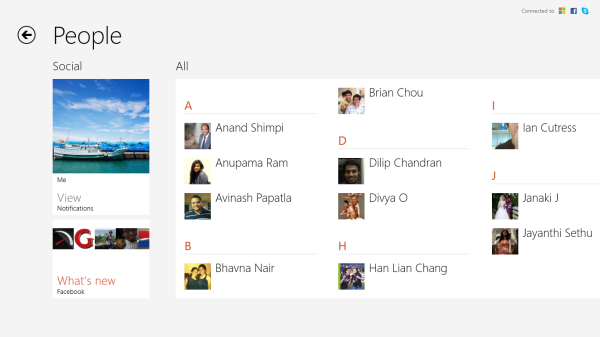

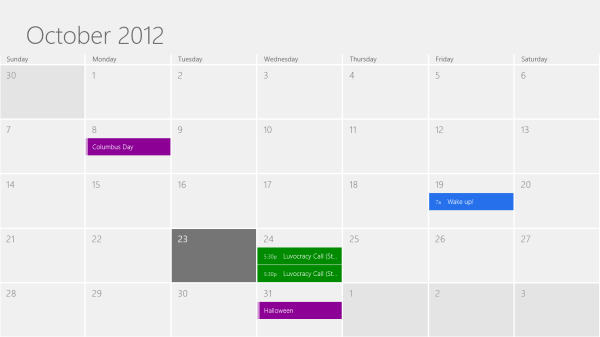
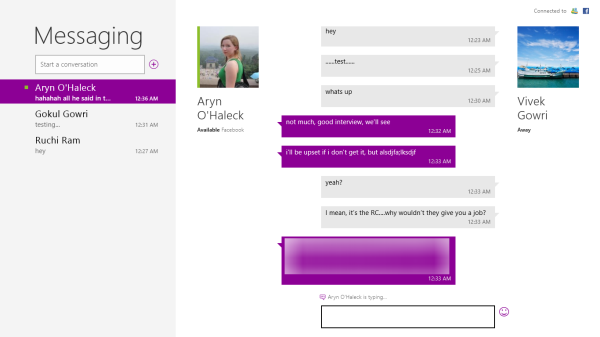

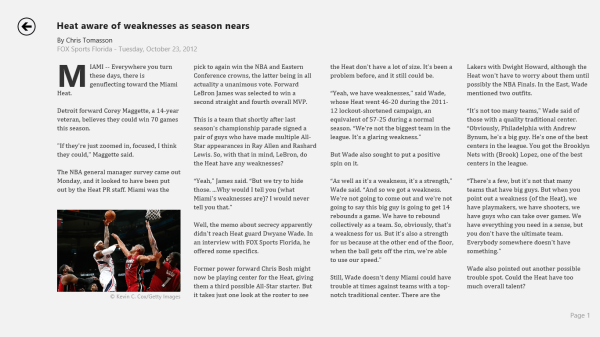
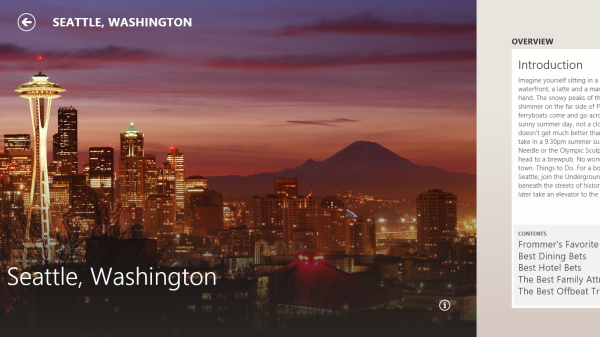








233 Comments
View All Comments
steven75 - Friday, November 2, 2012 - link
Yes, agreed 100%. This review seems to be by far the most certain the *metro* apps are going to grow by leaps and bounds than any other review I've read. I think there's definitely a chance RT and thus metro apps aren't going to take off at all.karasaj - Thursday, October 25, 2012 - link
Forgot to say thanks, great review! I was wondering about the smoothness of Surface etc - it doesn't seem like there will be much to worry about. Thanks again!nedjinski - Thursday, October 25, 2012 - link
Thanks for yet another sane and unbiased review. I find this approach the most helpful when considering a new purchase. You guys continue to have clear vision when it comes to the big picture and you don't get distracted by small details that will probably get ironed out in future iterations of the device.It looks like MS has a winner here.
Netscorer - Thursday, October 25, 2012 - link
While this is an overall very good and comprehensive review, I am still confused by two separate Windows 8 OS (with Windows Mobile 8 may be third). I just don't see how they are going to coexist long term. And if there will be convergence, which OS will be left out.I was hoping review would touch on those issues a bit more then spending page after page describing various apps that come built in and will undergo a significant change/enhancement shortly anyway.
haukionkannel - Thursday, October 25, 2012 - link
Well the Metro UI aplication will be very popular in Mobile platforms. Because both windows 8 versions can run those, there is no problem in there. If you want to run normal desktop application, video editing, AAA games, the normal 86 version of win8 is for you.If you have to chose between normal win8 and win8 RT pad, or tablet there is not very big difference. In most cases it is better for programmers to make Moder UI version of their program than to make only Intel CPU based version that runs only in normal win8 version. Thre will be more customers in Modern UI platform than normal. So instead of having bottle neck with old gaming consoles, the new botleneck will be the slovest win8 RT pad in most cases.
If you are serious gamer the normal win8 is for you. If you are interested in just getting pad for playing casual games like Angry bird, and reading www-pages, listening music, looking viodeos, etc, it does not matter what you get, if the price is good and ahrdware desent.
AmdInside - Thursday, October 25, 2012 - link
Waiting for MAME to be available for either Windows RT or Windows 8 before I buy a tablet.ludikraut - Thursday, October 25, 2012 - link
Oh yeah, MAME on a tablet will rock.l8r)
jecastejon - Thursday, October 25, 2012 - link
I am interested, reading and taking notes but is this Windows RT a netbook-nettop OS at a higher price point?I think I will wait at least 2-4 years to consider an ARM-Atom based computer to produce even some light work, as for a device to have fun there are tablets, Nintendo, PSP, iDevices with thousands of apps or games. WRT is not that cool, it does nothing better as an entertaining system but it may be great to produce very light or limited work on the office and just probably on the go but even for that it will need to compete with entry-laptops and ultralight machines.
Right now this is a very hybrid concept targeting for a broad marked but I just can see a niche market I am sure it will reach. I think in part the price is to high and it will be kind of a business ultra light high end system.
diamondsw2 - Thursday, October 25, 2012 - link
"85% (or more) of computers being sold worldwide"I assume you're not including iPad sales - which is very misleading for a tablet OS review. And if you're more broadly talking Windows 8 all of a sudden (RT != 8), the overwhelming majority of Windows sales are to businesses - and those businesses are going to exercise their downgrade rights and not touch Windows 8 with a ten-foot pole. There's no business case for it over Windows 7, and the training is far from insignificant. It's not going to get any headway there for years.
Consider be very skeptical on actual uptake of Windows 8 or its supposed marketshare. I'll bet it's six months to a year before I see the first person using it (which may say more about how many of my PC-using friends have converted to iPads and Macs). I fully expect every Windows PC I see to be on 7 for a long time to come).
PsychoPif - Thursday, October 25, 2012 - link
Just from a quick search, I've found that Apple sold 15.4m IPad vs 49.8m for the top 4 OEM. It does'nt include the other manufacturer and it's still 70% marketshare.85% might be high, but don't make it sound like Windows won't be on the vast majority of computer sold this year.